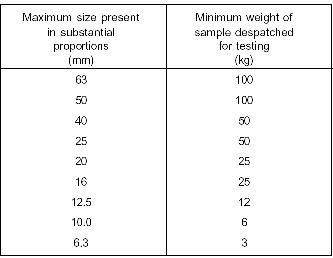SIEVE ANALYSIS
Sieve analysis helps to determine the particle size distribution of the coarse and fine aggregates.This is done by sieving the aggregates as per IS: 2386 (Part I) – 1963. In this we use different sieves as standardized by the IS code and then pass aggregates through them and thus collect different sized particles left over different sieves.
The apparatus used are –
i) A set of IS Sieves of sizes – 80mm, 63mm, 50mm, 40mm,31.5mm, 25mm, 20mm, 16mm, 12.5mm, 10mm, 6.3mm,4.75mm, 3.35mm, 2.36mm, 1.18mm, 600µm, 300µm, 150µm and 75µm.
ii) Balance or scale with an accuracy to measure 0.1 percent of the weight of the test sample.
The weight of sample available should not be less than the weight given below:-

The sample for sieving should be prepared from the larger sample either by quartering or by means of a sample divider.
Procedure to determine particle size distribution of Aggregates.
i) The test sample is dried to a constant weight at a temperature of 110 + 5oC and weighed.
ii) The sample is sieved by using a set of IS Sieves.
iii) On completion of sieving, the material on each sieve is weighed.
iv) Cumulative weight passing through each sieve is calculated as a percentage of the total sample weight.
v) Fineness modulus is obtained by adding cumulative percentage of aggregates retained on each sieve and dividing the sum by 100.
Reporting of Results
The results should be calculated and reported as:
i) the cumulative percentage by weight of the total sample
ii) the percentage by weight of the total sample passing through one sieve and retained on the next smaller sieve, to the nearest 0.1 percent. The results of the sieve analysis may be recorded graphically on a semi-log graph with particle size as abscissa (log scale) and the percentage smaller than the specified diameter as ordinate.
If you have a query, you can ask a question here.



What is the qualification of the agregates in terms of its particle size distribution